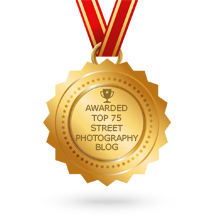In today's blog, I'd like to share and showcase my first attempt at Intentional Camera Movement a.k.a. ICM street photography. Without further ado, let's jump right in.
What is ICM in photography? ICM stands for Intentional Camera Movement, is an abstract style of shooting that has no rules – it all comes down to moving your camera over a long exposure to create an artistic or painting-like effect.
Personally. I like the no rules notion but it all comes down to the individual's or in this case, the photographer's vision and creativity. There's nothing new about ICM. I mean it's not a newly discovered photographic technique. Creating a well-executed and well-captured blurry image with aesthetics requires lots of practicing and shooting; initial trials and errors, before mastering the technique to create one's own signature style. Actually, there are no rights or wrongs in ICM photography. It's how you want to express yourself with your camera.
Anyway, this was my first attempt at ICM. A new learning curve for me, applying this shooting technique to street photography. As I was finding my way back to street photography after being on hiatus for too long amid post-pandemic, I was seeking new inspirations and then I came across ICM. In the world of photography, sharpness is overrated. In my usual street photography, either I shoot film or digital, I intend to focus, well mostly zone focus, to get my subjects as tack sharp as possible. However, in ICM everything is intentionally blurry using camera moment or deliberately out of focus.
In a sense, I'm trying to get out of my comfort zone and make photos that I feel uncomfortable. So after a brief study on ICM shooting technique, equipment, and camera settings, I picked up my trusted Nikon D70s with a mounted Tamron 17-35mm lens and hit the streets.
Wait a minute! What!? D70s!?
Yes, it's an old DSLR camera which I bought in 2004 and incredibly it stays with me all these years. After my RICOH GR2 went dead on me 2 years ago, my D70s is my go-to camera for street photography. Though I can't bring it along with me for daily shooting, not as convenient as GR2 it is still considered compact and light weigh compared to other new DSLR models. It's a simple-to-use DSLR camera without complex menu settings and the right tool for me.
In this blog, I will be sharing my own personal shooting experience with you. If you're keen to learn ICM, you can find tutorials on the internet and on YouTube. All my ICM street photos are made in RAW format and converted to black and white in Adobe Photoshop. So here goes for the first photo.
First of all, I have no agenda or what to expect for ICM street photography. I gotta start from somewhere so I decided to make my way to Chinatown and see what I would get. I came upon this scene and thought of taking a test shot. I have preset my aperture to the smallest at f/22.0 of focal length at 24mm (equivalent to 36mm on film or full frame; Nikon D70s has a 1.5 crop factor). Next, I set my shutter speed as slow as 1/8 second at the lowest ISO of 200 (the lowest in most Nikon entry-level DSLR cameras). I read in an article that an ND filter lens is required to cut down light but the weather on that day was overcast, I thought I'd go without one.
Focusing-wise, I set it on Auto Focus mode, and focus it on the front subject. Upon pressing the shutter, I moved the lens slightly downward and this is the result. I could set a slower shutter speed of 1/4 second for a more blurry effect, but I think this works for me as I want some parts of the photo to be distinguishable. The photo was processed and cropped in a 16:9 aspect ratio.
With the first test shot being a little "success", I kept on looking out for interesting ICM subjects. Here, I came to this row of shophouses along Erskine Road. In this round, the same setting except the aperture is closed down to f/25.0 and the lens is moved down when the shutter is released. After a few shots, I chimped and thought I have a keeper and then I move on to the next location. During editing and processing, I find this one with a pleasing result and decided to crop it in a 16:10 aspect ratio.
Ann Siang Hill is just around the corner. Hence, I went there to check out the area and came to a spiral staircase. As I went down I saw this curvy pavement so I thought it would be a good ICM subject to shoot. Below is a color and monochrome version. The blurry softness has this painting-like effect I really like. It has this dreamy feel and isn't over the top on the abstract side. You can click and move the slider for comparison. Which version do you like best? Let me know in the comment section below.
Photos info:
Focal Length @ 20.0mm | f/22.0 | 1/8 second | ISO 200 | Center Weight Metering
Next, I arrived at the junction between Telok Ayer Street and Boon Tat Street, where the Muslim shrine, Nagore Dargah is situated. There are doors on the sides of the shrine and then there are people walking by from time to time. Yeah, should be ideal for ICM photography I thought. So I set myself up on the opposite side facing the panel of doors, waiting for people to walk by. In street photography, this is called the Fishing Technique. Simply just stand in one spot that we like, then wait till the right subject enters the scene and takes the shot. I didn't wait too long, within 5 mins, I managed to make these 3 photos.
Further to the right of the doors, parked a Mini Rover Cooper and I wanted to try if ICM works on this subject or not, and it turns out quite okay to me. Again, here are 2 versions for comparison.
Photo info:
Focal Length @ 24.0mm | f/25.0 | 1/6 second | ISO 200 | Center Weight Metering | 16:10 aspect ratio
I carried on walking and roaming around the Far East Square area along Cross Street towards Hong Lim Complex along Upper Cross Street and finally arrived at Chinatown Point. While taking a short break, I saw 2 women posing for selfies against a Mid-Autumn Festival decorations of lanterns and other related props right at the shopping mall's main entrance. So I thought I'd give it a shot and here's the result.
 |
Photo info: Focal Length @ 24.0mm | f/25.0 | 1/6 second | ISO 200 | Center Weight Metering | 16:9 aspect ratio |
Summing up:
Before we come to the end of the blog, I want to share my thoughts on ICM photography. I must admit it is very easy and fun to do and I really enjoy it. When I go out doing street photography, I tend to have an idea or a few in my head of what I'm after. I do, however, like to walk freely with my camera and see what the streets offer.
When it comes to ICM street photography, I have to constantly pre-visualize and look out for interesting subjects in contrast to bright backgrounds, to achieve the desired effects. Suffice it to say, ICM poses great challenges. If done right, I may get amazing results.
Talking about the softness and blurry effects in ICM, I believe there are many other possible ways of creating more interesting results using lenses from Lensbaby and the Lomography New Petzval 85 Art Lens. Check out the respective website for more details on these lenses and their crazy Bokeh effects. Just imagine the Bokehs from these lenses and apply the ICM shooting technique, the results and creativity are limitless.
Well, you don't have to own any of these lenses to do ICM. As mentioned before, there are no rules in ICM photography. Again, there are no rules on which lens you have to use, as it all comes down to the composition and framing of the shot you are after. After my first attempt, I think I should try it with other lenses for different images and different effects. Say, a telephoto zoom lens 70-300mm for zooming effect?
OK, that's it for today's blog. I hope you enjoy reading and viewing my new work. If you like my work, do subscribe to my blog for new updates. Thank you and take care.























No comments:
Post a Comment